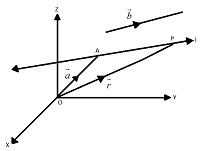Vectors – Equation of Straight Line
Equation of Straight Line passing through a given Point and Parallel to a given Vector
Vector Form: Line passing through point \(A(\overline{a})\) and parallel to vector \(\overline{b}\).

Let A be the given point and let AP be the given line through A.
Let \(\overline{b}\) be any vector parallel to the given line.
Position vector of point A is \(\overline{a}\).
Let P be any point on line AP, and let its position vector be \(\overline{r}\).
Then, we have
\(\overline{r}=\overline{OP}=\overline{OA}+\overline{AP}\)\(\overrightarrow{r}=\overrightarrow{a}+\lambda \overrightarrow{b}\) … (1)
Here, \(\overline{r}\) is the position vector of any point P (x, y) on the line. So \(\overrightarrow{r}=x\hat{i}+y\hat{j}+z\hat{k}\).
In, particular, the equation of straight line through origin and parallel to \(\overline{b}\) is \(\overrightarrow{r}=\lambda \overrightarrow{b}\).
Cartesian Form: Let the coordinates of the given point A be (x₁, y₁, z₁) and the direction of the line be a, b and c. Consider the coordinates of any point P be (x, y, z). then
\(\overrightarrow{r}=x\hat{i}+y\hat{j}+z\hat{k}\),
\(\overrightarrow{a}={{x}_{1}}\hat{i}+{{y}_{1}}\hat{j}+{{z}_{1}}\hat{k}\) and
\(\overrightarrow{b}=a\hat{i}+b\hat{j}+c\hat{k}\).
Substituting these values in (1) and equating the coefficients of \(\hat{i},\ \hat{j}\) and \(\hat{k}\). We get
x = x₁ + λa
y = y₁ + λb
z = z₁ + λc
These are parametric equation of the line.
Eliminating the parameter λ, we get \(\frac{x-{{x}_{1}}}{a}=\frac{y-{{y}_{1}}}{b}=\frac{z-{{z}_{1}}}{c}\).
Note:
- Here any point on the line is (x, y, z) ≡ (x₁ + λa, y₁ + λb, z₁ + λc)
- Since the x, y and z – axes pass through the origin and have direction cosine (1, 0, 0), (0, 1, 0) and (0, 0, 1), their equations are
Equation of x – axis: y = 0, z = 0,
Equation of y – axis: x = 0, z = 0,
Equation of z – axis: x = 0, y = 0.
